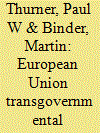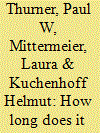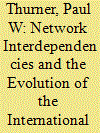|
|
|
Sort Order |
|
|
|
Items / Page
|
|
|
|
|
|
|
| Srl | Item |
| 1 |
ID:
157351


|
|
|
|
|
| Summary/Abstract |
Do norms constrain states’ foreign policies even in the face of strong economic incentives to ignore them? Arms exports provide an excellent opportunity to examine this question more closely. They regularly spark fierce political debates on whether to trade goods that buyers might deploy with devastating effects. We use the case of German arms exports to provide an in-depth statistical analysis of the behavior of a major arms exporter that claims to follow high normative standards. In particular, we investigate to what extent domestic, supranational, and international rules and norms shape German decisions about the destination and volume of major conventional weapon deliveries. Using panel data for the period 1953–2013, we employ a Heckman selection model to capture the two-step nature of the decision-making process. We find that German arms export policies often fail to comply with standards that prohibit exports to countries embroiled in military conflicts, civil wars, or with strong human rights violations. Furthermore, we discover, however, that the country fully complied with multilateral arms embargoes after 1990. We conclude that the noneffectiveness of certain rules and norms stems from both the ambiguity of norms and the opacity of decision-making processes.
|
|
|
|
|
|
|
|
|
|
|
|
|
|
|
|
| 2 |
ID:
150869


|
|
|
|
|
| Summary/Abstract |
The profitability of nuclear power plant investment is largely determined by the construction duration, which directly impacts discounted cash flows, debt and interest payments, as well as variable costs, such as labor. This paper analyzes the key drivers of construction duration using survival models. We focus especially on the strategic expectation formation of private and public utilities engaging in such highly risky megaprojects. Using a balanced dataset of explanatory variables and the IAEA/PRIS dataset of reactor construction starts between 1950 and 2013 we find that the expectation of rising oil prices and higher economic growth, along with the higher per capita GDP of a country tend to reduce the time needed to grid connection. We also identify the reactor models with the fastest construction duration.
|
|
|
|
|
|
|
|
|
|
|
|
|
|
|
|
| 3 |
ID:
086753


|
|
|
|
|
| Publication |
2009.
|
| Summary/Abstract |
Does the European Union (EU) represent a new political order replacing the old nation-states? The assessment of the real character of political orders requires the identification of political key actors and of the specific structure of their interactions. Transgovernmental networks have been considered to be one of the most important features of EU integration. Unfortunately, the network structures, processes and the impact of these informal horizontal inter-organisational relations between nation-states are mostly unknown. The main objective of this article is to measure and explain the selective pattern of informal bilateral relations of high officials of the EU Member States' ministerial bureaucracies on the occasion of an EU Intergovernmental Conference. The quantitative data used rely on standardised interviews with 140 top-level bureaucrats. The statistical estimation of network choices is based on recent developments of exponential random graph models.
|
|
|
|
|
|
|
|
|
|
|
|
|
|
|
|
| 4 |
ID:
132767


|
|
|
|
|
| Publication |
2014.
|
| Summary/Abstract |
Governments deciding to use nuclear energy as part of their country×s energy mix are faced with long-term planning efforts and huge investments. As nuclear power plants constitute one of the socially and politically most contested technologies, the question arises, which time horizons companies as well as politicians have to consider for the accomplishment and grid-connection of individual and whole fleets of reactors. Unfortunately, there are no large-N studies investigating the time for completion of such large-scale projects. For the first time, we statistically explain the duration of the construction of all initiated nuclear plant projects so far. Based on the International Atomic Energy×s comprehensive Power Reactor Information System (PRIS) we assess the impact of demographic, economic, and political preconditions of a country, at the same time accounting for different types of reactor technologies. To account for non-linear relationships, we apply non-parametric survival models with P-splines. A main result of our analysis is that time of connection to grid increases over the years indicating increased societal sensibilities, respect for higher security standards, and increased project complexities. The Harrisburg and the Chernobyl disaster did not induce a separate additional delaying effect.
|
|
|
|
|
|
|
|
|
|
|
|
|
|
|
|
| 5 |
ID:
174726


|
|
|
|
|
| Summary/Abstract |
Although often conjectured, there is a lack of empirical evidence whether international inflows of military technology render intrastate conflicts more violent. We address this question and argue that expansions in governments’ ability to fight aggravate the lethality of intrastate war. However, we expect this effect to be conditioned by rebels’ military endowments and their choice of tactics. Where rebels are weak, they avoid open combat, and additional governmental arms imports have no effect on the number of casualties. In contrast, governmental arms imports cause human losses to multiply when rebels have achieved military parity or superiority and, as a consequence, use conventional combat tactics. This hypothesis is tested on the number of battle-related deaths in intrastate conflict, 1989 to 2011, using, for the first time, data on governmental imports of both major conventional weapons and small arms. Results support our propositions and are robust to instrumenting for imports of both types of weapons.
|
|
|
|
|
|
|
|
|
|
|
|
|
|
|
|
| 6 |
ID:
167382


|
|
|
|
|
| Summary/Abstract |
Since few states are able to produce all of their own military hardware, a majority of countries’ military systems rely on weapon imports. The structure of the international defense technology exchange network remains an important puzzle to understand, along with the factors that drive its evolution. Drawing on a political economy model of arms supply, we propose a new network-oriented explanation for the worldwide transactions of major conventional weapons in the period after World War II. Using temporal exponential random graph models, our dynamic approach illustrates how network dependencies and the relative weighting of economic versus security considerations vary over time. One of our major results is to demonstrate how security considerations started regaining importance over economic ones after 2001. Additionally, our model exhibits strong out-of-sample predictive performance, with network dependencies contributing to model improvement especially after the Cold War.
|
|
|
|
|
|
|
|
|
|
|
|
|
|
|
|
| 7 |
ID:
153088


|
|
|
|
|
| Summary/Abstract |
This paper analyzes the impact of arms imports and exports on national military expenditures. The recent literature on the determinants of military expenditures has mainly focused on countries’ external security environments and their regime type. Based on existing theoretical work, we argue that, in addition to these factors, arms trade flows may have an important role to play. First, we show that rising imports of major conventional weapons do not necessarily translate into higher defense spending. Rather, this relationship depends on political, economic, and contract conditions that influence different choices of financing imports. Therefore, the effect should be very heterogenous. Second, exports may have both a negative or a positive impact depending on regime type and the perceived impact of exports on national security. We empirically test these expectations for 156 countries from 1949 to 2013 using arms trade and new military expenditure data provided by SIPRI. Employing static and dynamic panel data models, we find that the effect of arms imports on defense budgets does indeed differ between regions and time periods. With respect to exports, there is evidence of a strategic substitution effect between military expenditures and arms exports in democratic countries: increases in arms exports are followed by a reduction in military expenditures. For non-democratic societies on the other hand, arms exports do not tend to be associated with lower military spending.
|
|
|
|
|
|
|
|
|
|
|
|
|
|
|
|
|
|
|
|
|